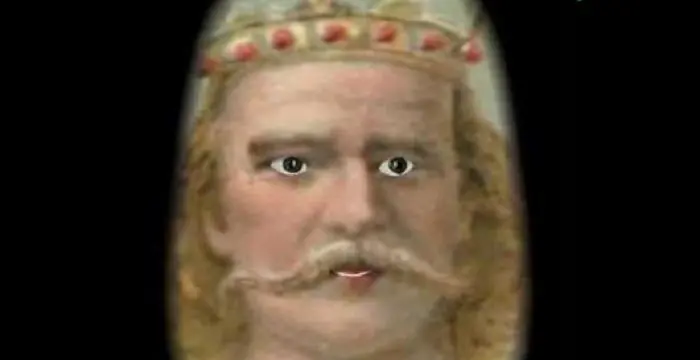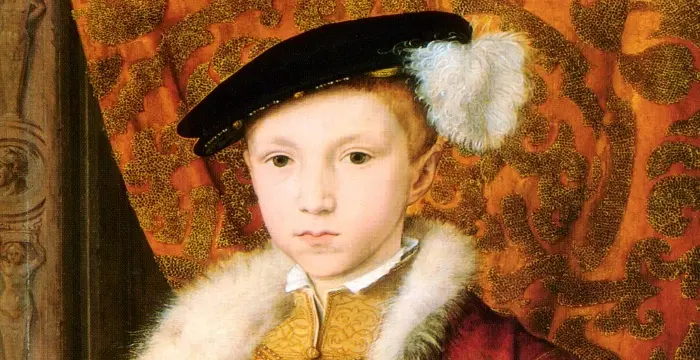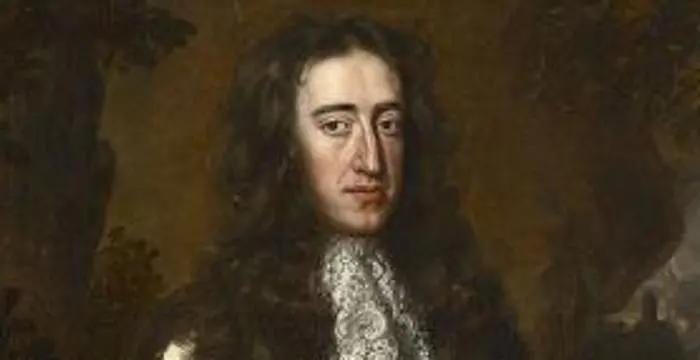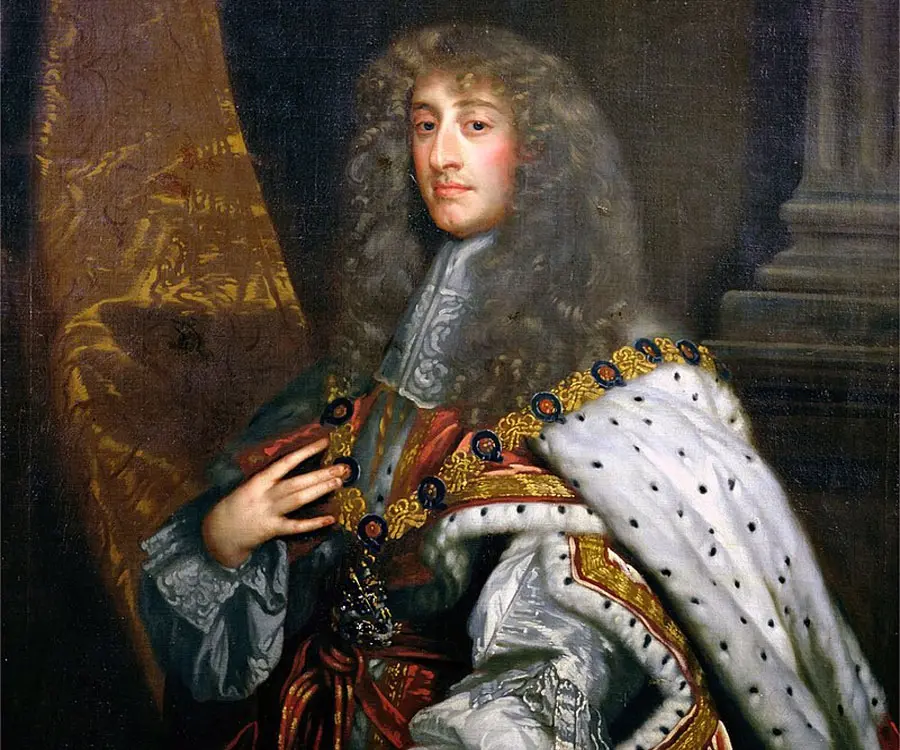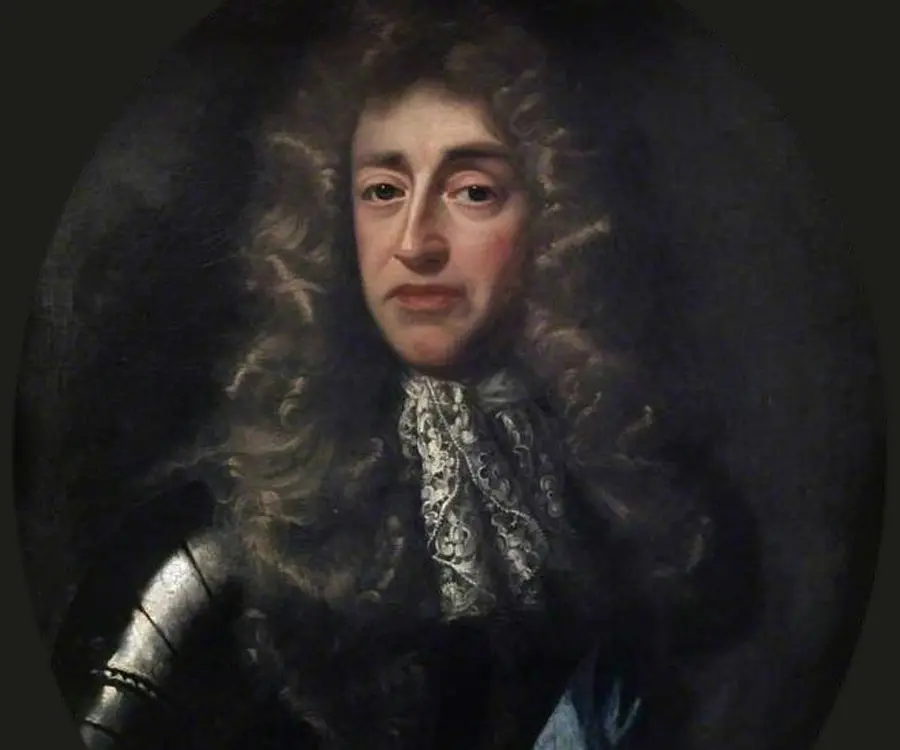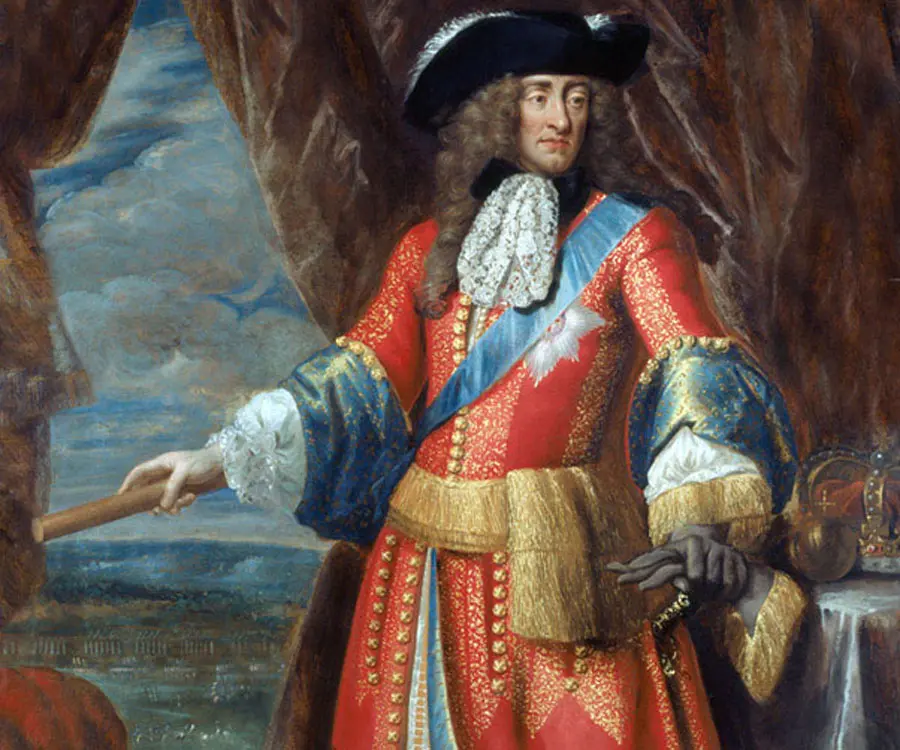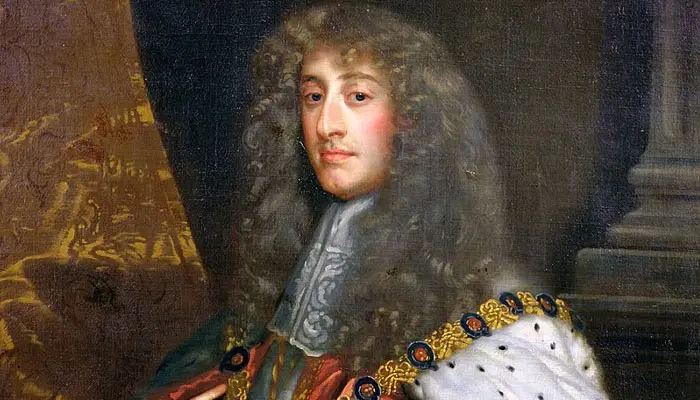
James II of England - Kings, Birthday and Family
James II of England's Personal Details
James II of England was the second son of King Charles I and Henrietta Maria
| Information | Detail |
|---|---|
| Birthday | October 14, 1633 |
| Died on | September 16, 1701 |
| Nationality | British |
| Famous | Historical Personalities, Emperors & Kings, Leaders, Emperors, King of England, Kings |
| Spouses | Anne Hyde, Mary of Modena |
| Siblings | Charles II of England, Duke of Gloucester, Elizabeth Stuart, Henry Stuart, Mary, Princess Anne of England, Princess Henrietta of England, Princess Royal and Princess of Orange |
| Known as | James VII of Scotland, King James II of England |
| Childrens | Mary II of England |
| Birth Place | London |
| Religion | Roman Catholic Church |
| Gender | Male |
| Father | Charles I of England |
| Mother | Henrietta Maria of France |
| Sun Sign | Libra |
| Born in | London |
| Famous as | King of England |
| Died at Age | 67 |
// Famous King of England
Harold Godwinson
Harold Godwinson was an Anglo Saxon King of England in the 11th Century. Check out this biography to know about his birthday, childhood, family life, achievements and fun facts about him.
Edward VI of England
Edward VI served as the King of England, from 1547 until his death in 1553. Check out this biography to learn in details about his life, his works as a king and timeline
William III of England
William III was the stadtholder of the main provinces of the Dutch Republic and the king of England, Ireland, and Scotland (King William II of Scotland). Check out this biography to know more about his childhood, family, life history, etc.
James II of England's photo
Who is James II of England?
James II of England was the second son of King Charles I and Henrietta Maria. After the death of his brother Charles II, he ruled as James II of England and Ireland and James VII of Scotland, till he was deposed to France by the Glorious Revolution. Earlier, he and his brother had to seek refuge in France when his father was executed in the British Civil War. He served in the French and Spanish armies during his exile and proved himself to be a military leader. When his brother was restored to the throne of England he was created Duke of Albany in Scotland and given command of the Royal Navy during the Second and Third Anglo-Dutch Wars. He was influenced by the Roman Catholic Church during the period he was in France and secretly followed the faith till he officially left the Church of England and married Mary of Modena, after the death of his first wife. Soon after his coronation, he faced two rebellions after which he expanded his standing army and did away with laws punishing Catholics and Protestant dissenters which brought about confrontation between him and the Archbishop of Canterbury and Anglican supporters. He was ultimately defeated by Prince William and had to again flee to France where he died at the age of 67.
// Famous Emperors
Sundiata Keita
Sundiata Keita was the founder of the Mali Empire in West Africa. This biography profiles his childhood, early life, struggles, founding of empire, rule, administration, achievements and also gives some fun facts.
Ashoka
Ashoka was the third emperor of the Mauryan Dynasty and ruled almost the entire Indian subcontinent. This biography profiles his childhood, life, reign, achievements and timeline
Murad IV
Murad IV was one of the mighty Sultans in the history of the Ottoman Empire. This biography profiles his childhood, family, accession, rule, administration and timeline.
Childhood & Early Life
James II was born on October 14, 1633 at St James’s Palace, London to King Charles I and Henrietta Maria of France. He was the second surviving son of his parents after his brother Charles II.
He was privately educated with his brother and the two sons of the Duke of Buckingham and Francis Villiers. He was designated as Duke of York at birth and appointed Lord of Admiral at the age of three, which made him the titular head of the Royal Navy as an adult. In 1642, he was invested with the Order of the Garter, which was considered to be the most prestigious British order of chivalry.
He accompanied his father to the Battle of Edgehill during the English Civil War, where he was almost captured by the Parliamentary army. He was conferred with a Master of Arts degree from Oxford University in 1642 and served as a Colonel of the volunteer regiment of foot.
In 1946, he was confined to St James’s Palace by the Parliamentary army, from where he escaped disguised as a woman and crossed the North Sea to The Hague on the western coast of Netherlands.
When his father was executed by the rebels in 1649, the loyalists declared his elder brother, Charles II as King. However, his brother failed to secure the throne of England and they both had to seek refuge in France.
Career
He served in the French army under Turenne in the French Civil Wars, where he gave a gallant account of himself during his first true exposure to battle. In appreciation, he was given command of a captured Irish regiment in 1652 and made Lieutenant General in 1654.
James and his brother were exiled from France when Charles II aligned himself with Spain to try and regain the throne of England. He joined the Spanish army under Louis, Prince of Conde and was given command of six regiments of British volunteers that fought against his former French comrades in the Battle of the Dunes in 1658.
Charles II was restored to the throne of England in 1660 and James was created Duke of Albany in Scotland. He was confirmed Lord High Admiral and was appointed Governor of Portsmouth and Lord Warden of the Cingue Ports. He was also made Governor of the Royal Adventure into Africa.
He commanded the Royal Navy during the Second Anglo-Dutch War from 1665 to 1667 and the Third Anglo-Dutch War from 1672 to 1674. During this period he consolidated the British hold over the African coast to facilitate slave trade.
In 1664, his brother gave him charge of the American territory captured from the Dutch between the Delaware and Connecticut rivers. The port of New Amsterdam was renamed the City of New York to honour James (Duke of York).
Because of his Catholic faith, James had to leave England and move to Brussels on orders of his brother because there was opposition to his becoming King in case Charles failed to have a legitimate child. However, when a plot to kill him and his brother hatched by the illegitimate son of Charles and supporters of a republican revolution was discovered he gained sympathy and returned to England.
When Charles II died due to apoplexy, without any legitimate children, he was crowned James II, King of England and Ireland and James VII of Scotland on 23 April 1685. He worked harder than his brother and was less accommodative towards his advisors who did not agree with him on certain issues.
Soon after his coronation, he faced two rebellions led by his nephew, the Duke of Monmouth, in southern England and the Earl of Argyll in Scotland. Both rebellions were defeated by his army and his opponents were sentenced to death.
He expanded his standing army and allowed Roman Catholics to command regiments and hold important offices in his kingdom without the oath mandated by the Test Act. This brought about confrontation between him and the Archbishop of Canterbury and Anglican supporters.
He repealed penal laws against Catholics and used his dispensing powers to do away with laws punishing Catholics and Protestant dissenters. He also reduced the Anglican monopoly on education.
The fact that he had only two daughters from his first marriage and the possibility of him having a Catholic son from his second marriage as his successor further created revolt by the Anglicans which was led by Prince William of Orange.
When his own daughter defected to join Prince William, James declined to attack the invading army and fled to France, where he was received by his cousin, Louis XIV. His daughter Mary was declared Queen and her husband, William, became King of England and Scotland.
James moved to Ireland and was declared King where he granted religious freedom to Catholics and Protestants. He raised an army but was ultimately defeated by King William in the Battle of the Boyne in 1690 and had to once more seek refuge in France.
During his last days he lived in the royal chateau of Saint Germain-en-laye in France with his wife and a few loyal supporters. He died at the age of 67 due to brain haemorrhage on September 16, 1701.
Awards & Achievements
James held the titles of ‘The Duke of York’ (14 October 1633 – 06 February 1685), ‘The Earl of Ulster’ (10 May 1659 – 06 February 1685), ‘The Duke of Albany’ (31 December 1660 – 06 February 1685) and ‘His Majesty The King’ (06 February 1685 – 11 December 1688).
He was honoured with the Knight of the Garter on April 20, 1660.
Personal Life
James courted Anne Hyde who was a commoner and promised to marry her after he got her pregnant. This created a controversy after his brother was restored as King, because a prince was not expected to marry a commoner. Despite all opposition, he got married to Anne in September 1660.
His first child was born two months after his marriage but died at infancy. Only two of his eight children survived to adulthood. He was devoted to his family and played with his children, which was not the norm for royalty in those days. Anne Hyde influenced many of his decisions, till she died in 1671.
He was influenced by the Roman Catholic Church during the period he was in France. He secretly followed the faith till he officially left the Church of England and converted in 1673. In September 1673, he married Mary of Modena, who was a fifteen year old Roman Catholic Italian princess. They had 12 children of whom only two survived to adulthood.
James is known to have had many mistresses, including Catherine Sedley and Arbella Churchill from whom he had children.
Trivia
James won the hearts of the people of London by his gallant actions when he was made in charge of the fire fighting operations to quench the Great Fire of London in 1666.
After the rule of James II, a bill was passed in the British parliament that henceforth no Roman Catholic would be permitted to be King of England and no English monarch would be permitted to marry a Roman Catholic.
// Famous Kings
Sundiata Keita
Sundiata Keita was the founder of the Mali Empire in West Africa. This biography profiles his childhood, early life, struggles, founding of empire, rule, administration, achievements and also gives some fun facts.
Ashoka
Ashoka was the third emperor of the Mauryan Dynasty and ruled almost the entire Indian subcontinent. This biography profiles his childhood, life, reign, achievements and timeline
Murad IV
Murad IV was one of the mighty Sultans in the history of the Ottoman Empire. This biography profiles his childhood, family, accession, rule, administration and timeline.
James II of England's awards
| Year | Name | Award |
|---|---|---|
Other | ||
| 0 | Fellow of the Royal Society | |
James II of England biography timelines
- // 14th Oct 1633James II was born on October 14, 1633 at St James’s Palace, London to King Charles I and Henrietta Maria of France. He was the second surviving son of his parents after his brother Charles II.
- // 1642He was privately educated with his brother and the two sons of the Duke of Buckingham and Francis Villiers. He was designated as Duke of York at birth and appointed Lord of Admiral at the age of three, which made him the titular head of the Royal Navy as an adult. In 1642, he was invested with the Order of the Garter, which was considered to be the most prestigious British order of chivalry.
- // 1642He accompanied his father to the Battle of Edgehill during the English Civil War, where he was almost captured by the Parliamentary army. He was conferred with a Master of Arts degree from Oxford University in 1642 and served as a Colonel of the volunteer regiment of foot.
- // 1649When his father was executed by the rebels in 1649, the loyalists declared his elder brother, Charles II as King. However, his brother failed to secure the throne of England and they both had to seek refuge in France.
- // 1652 To 1654He served in the French army under Turenne in the French Civil Wars, where he gave a gallant account of himself during his first true exposure to battle. In appreciation, he was given command of a captured Irish regiment in 1652 and made Lieutenant General in 1654.
- // 1658James and his brother were exiled from France when Charles II aligned himself with Spain to try and regain the throne of England. He joined the Spanish army under Louis, Prince of Conde and was given command of six regiments of British volunteers that fought against his former French comrades in the Battle of the Dunes in 1658.
- // 1660Charles II was restored to the throne of England in 1660 and James was created Duke of Albany in Scotland. He was confirmed Lord High Admiral and was appointed Governor of Portsmouth and Lord Warden of the Cingue Ports. He was also made Governor of the Royal Adventure into Africa.
- // 20th Apr 1660He was honoured with the Knight of the Garter on April 20, 1660.
- // Sep 1660James courted Anne Hyde who was a commoner and promised to marry her after he got her pregnant. This created a controversy after his brother was restored as King, because a prince was not expected to marry a commoner. Despite all opposition, he got married to Anne in September 1660.
- // 1664In 1664, his brother gave him charge of the American territory captured from the Dutch between the Delaware and Connecticut rivers. The port of New Amsterdam was renamed the City of New York to honour James (Duke of York).
- // 1666James won the hearts of the people of London by his gallant actions when he was made in charge of the fire fighting operations to quench the Great Fire of London in 1666.
- // 1671His first child was born two months after his marriage but died at infancy. Only two of his eight children survived to adulthood. He was devoted to his family and played with his children, which was not the norm for royalty in those days. Anne Hyde influenced many of his decisions, till she died in 1671.
- // Sep 1673He was influenced by the Roman Catholic Church during the period he was in France. He secretly followed the faith till he officially left the Church of England and converted in 1673. In September 1673, he married Mary of Modena, who was a fifteen year old Roman Catholic Italian princess. They had 12 children of whom only two survived to adulthood.
- // 23rd Apr 1685When Charles II died due to apoplexy, without any legitimate children, he was crowned James II, King of England and Ireland and James VII of Scotland on 23 April 1685. He worked harder than his brother and was less accommodative towards his advisors who did not agree with him on certain issues.
- // 1690James moved to Ireland and was declared King where he granted religious freedom to Catholics and Protestants. He raised an army but was ultimately defeated by King William in the Battle of the Boyne in 1690 and had to once more seek refuge in France.
- // 16th Sep 1701During his last days he lived in the royal chateau of Saint Germain-en-laye in France with his wife and a few loyal supporters. He died at the age of 67 due to brain haemorrhage on September 16, 1701.
- // 1946In 1946, he was confined to St James’s Palace by the Parliamentary army, from where he escaped disguised as a woman and crossed the North Sea to The Hague on the western coast of Netherlands.
// Famous Historical Personalities
Sundiata Keita
Sundiata Keita was the founder of the Mali Empire in West Africa. This biography profiles his childhood, early life, struggles, founding of empire, rule, administration, achievements and also gives some fun facts.
Ashoka
Ashoka was the third emperor of the Mauryan Dynasty and ruled almost the entire Indian subcontinent. This biography profiles his childhood, life, reign, achievements and timeline
Jetsun Pema
Jetsun Pema is the Queen consort of Bhutan. Check out this biography to know about her childhood, family life, achievements and fun facts about her life.
Murad IV
Murad IV was one of the mighty Sultans in the history of the Ottoman Empire. This biography profiles his childhood, family, accession, rule, administration and timeline.
Xerxes I
Xerxes I (Xerxes the Great) was the fourth and the most famous king of the Archaemenid dynasty of Persia. This biography profiles his childhood, family, personal life, life history, achievements, campaigns, administration, death and other facts.
Sargon of Akkad
Sargon of Akkad, also called ‘Sargon the Great’, ‘Sarru-Kan’ and ‘Shar-Gani-Sharri’, was the founder and first king of the Akkadian Empire. This biography profiles his childhood, life, rule, administration, timeline, and gives some fun facts.
James II of England's FAQ
What is James II of England birthday?
James II of England was born at 1633-10-14
When was James II of England died?
James II of England was died at 1701-09-16
Where was James II of England died?
James II of England was died in Saint-Germain-en-Laye
Which age was James II of England died?
James II of England was died at age 67
Where is James II of England's birth place?
James II of England was born in London
What is James II of England nationalities?
James II of England's nationalities is British
Who is James II of England spouses?
James II of England's spouses is Anne Hyde, Mary of Modena
Who is James II of England siblings?
James II of England's siblings is Charles II of England, Duke of Gloucester, Elizabeth Stuart, Henry Stuart, Mary, Princess Anne of England, Princess Henrietta of England, Princess Royal and Princess of Orange
Who is James II of England childrens?
James II of England's childrens is Mary II of England
What is James II of England's religion?
James II of England's religion is Roman Catholic Church
Who is James II of England's father?
James II of England's father is Charles I of England
Who is James II of England's mother?
James II of England's mother is Henrietta Maria of France
What is James II of England's sun sign?
James II of England is Libra
How famous is James II of England?
James II of England is famouse as King of England
